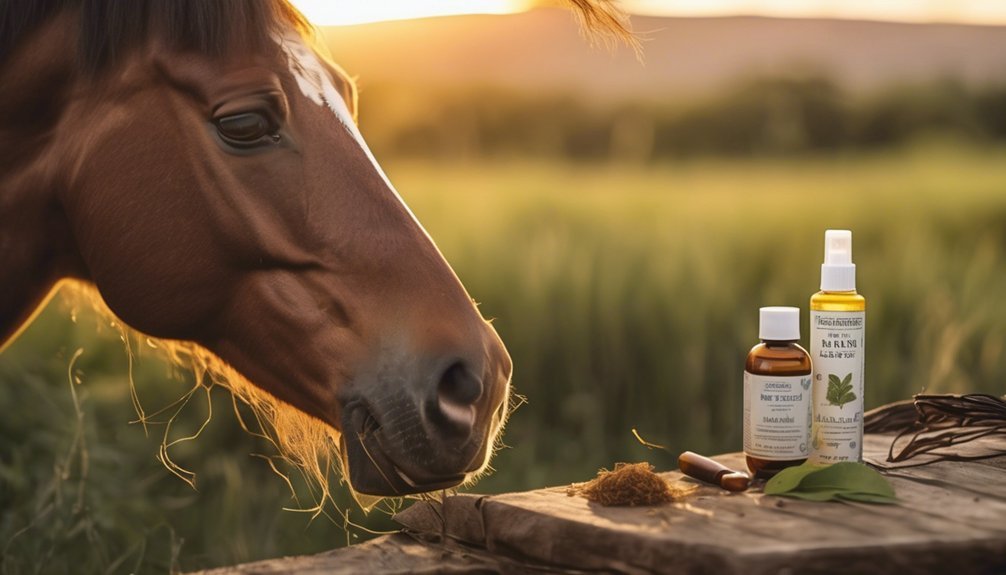
When it comes to preventing and treating horse lice, understanding their life cycle and signs of infestation is crucial. Regular inspections and good hygiene can significantly reduce the risk of an outbreak. If you notice any signs of lice, prompt action is necessary to protect your horse's health. There are various treatment options available, but selecting the most effective one can be challenging. Let's explore the best strategies to keep your horse lice-free and comfortable.
Key Takeaways
- Maintain excellent hygiene by regularly cleaning stalls, bedding, and grooming tools to prevent lice infestations.
- Inspect horses frequently for signs of lice, such as excessive scratching and visible nits in their coat.
- Use approved insecticides or natural remedies, like neem or essential oils, to treat identified infestations effectively.
- Isolate infested horses to minimize lice transmission and wash all equipment to eliminate environmental lice.
- Avoid sharing grooming tools between horses and limit exposure to crowded environments to reduce the risk of lice spread.
Understanding Horse Lice: Types and Life Cycle

Horse lice, though often overlooked, can significantly impact your horse's health and comfort. There are two primary lice types that affect horses: biting lice, which feed on skin debris, and sucking lice, which draw blood. Understanding these lice types is crucial for effective management.
The life cycle of horse lice consists of three stages: egg, nymph, and adult. Eggs, or nits, attach to your horse's hair and hatch into nymphs within a week.
These nymphs mature into adults in about two to three weeks, ready to reproduce and perpetuate the infestation. By recognizing this life cycle, you can take proactive steps to prevent lice infestations, ensuring your horse remains healthy and comfortable in their environment.
Signs and Symptoms of Lice Infestation
Recognizing the signs and symptoms of a lice infestation can help you address the issue before it escalates. Pay close attention to your horse's behavior; excessive scratching and biting at the skin are primary infestation indicators.
You might notice patches of hair loss or irritation in areas where lice thrive, such as the mane and tail. Look for tiny, white eggs (nits) clinging to the hair shafts, as this is a clear sign of infestation.
Additionally, observe your horse's overall demeanor—lice can cause discomfort, leading to restlessness or changes in appetite. By being vigilant and understanding these lice behaviors, you can take prompt action to ensure your horse's comfort and well-being.
Best Practices for Preventing Lice

To effectively keep lice at bay, it's crucial to implement a proactive management plan for your horse's environment and grooming routine.
Start by maintaining excellent equine hygiene; regularly clean stalls and bedding to minimize lice habitats. Ensure your horse has a dedicated grooming kit that's kept clean and free from contamination. Avoid sharing grooming tools with other horses, as this can spread lice.
Regularly inspect your horse for signs of lice, especially during seasonal changes. Additionally, consider limiting your horse's exposure to crowded environments where lice can thrive.
Grooming Techniques to Minimize Risk
Keeping your grooming routine sharp is essential for minimizing the risk of lice infestations. Utilize effective grooming tools and proper techniques to create a barrier against these pests. Regularly inspect your horse's coat for signs of lice and ensure your tools are clean and disinfected after each use.
| Grooming Tools | Proper Techniques |
|---|---|
| Soft-bristled brush | Brush against the hair |
| Metal comb | Focus on areas near ears |
| Hoof pick | Check for debris |
Treatment Options for Lice Infestation

When your horse is infested with lice, prompt action is crucial to alleviate discomfort and prevent further spread. You can consider several effective treatment options:
- Chemical treatments: Use approved insecticides specifically designed for equines.
- Topical applications: Apply lotions or sprays directly to affected areas for targeted relief.
- Isolation: Keep the infested horse away from others to minimize transmission.
- Thorough cleaning: Wash bedding, brushes, and any equipment to eliminate lice in the environment.
Remember to consult your veterinarian before starting any treatment, as they can recommend the best options for your horse's specific situation.
Your horse deserves comfort, and addressing lice infestations quickly will help restore their well-being.
Natural Remedies for Lice Control
While chemical treatments can effectively combat lice infestations, many horse owners look for natural alternatives that are gentler on their animals and the environment.
You might consider herbal solutions like neem or rosemary, which have insect-repelling properties. These herbs can be made into a soothing wash or a spray to apply on your horse's coat.
Additionally, essential oils such as lavender or tea tree oil can help deter lice when diluted and used in a spray form.
Always perform a patch test to ensure your horse doesn't have an adverse reaction.
Maintaining a Healthy Environment for Your Horse

Creating a healthy environment for your horse is essential for its overall well-being and can significantly reduce the risk of lice infestations.
To maintain stable cleanliness and effective bedding management, follow these key practices:
- Regularly clean and disinfect the stable to eliminate debris and waste.
- Replace bedding frequently to ensure it remains dry and comfortable.
- Inspect your horse's skin and coat regularly for signs of lice or irritation.
- Ensure proper ventilation in the stable to reduce humidity and promote a healthier atmosphere.
Frequently Asked Questions
Can Horse Lice Be Transmitted to Humans or Other Animals?
Horse lice transmission doesn't typically affect humans or other animals, focusing mainly on horses. However, maintaining proper hygiene and care is crucial for your horse's health, ensuring both you and your equine companion stay safe.
How Long Does a Lice Infestation Typically Last Without Treatment?
A lice infestation lasts around two to three weeks without treatment. If you don't intervene, the infestation duration can extend, complicating your horse's comfort and health. A timely treatment timeline is essential for relief.
Are Certain Horse Breeds More Susceptible to Lice Infestations?
Yes, certain horse breeds show more lice susceptibility due to their coat types and living conditions. Breed differences can affect how easily lice thrive, so understanding these factors helps you take proactive measures for your horse's health.
Can Horse Lice Survive in Bedding or Equipment?
Yes, horse lice can survive in bedding and on equipment. You should prioritize bedding cleanliness and equipment sanitation to minimize the risk of infestations, ensuring your horse remains comfortable and healthy throughout their care.
Is It Safe to Use Regular Insecticides on Horses?
Using regular insecticides on horses can be risky. You've got to consider chemical safety first. While they may show insecticide effectiveness, the potential harm to your horse's health isn't worth the chance. Always choose wisely.
Conclusion
In conclusion, while dealing with horse lice might seem daunting, taking proactive steps can make a significant difference. You might think that prevention is too time-consuming, but regular grooming and hygiene practices not only protect your horse but also strengthen your bond. By staying vigilant and using the right treatments, you can ensure your horse remains healthy and comfortable. Remember, a little effort goes a long way in safeguarding your horse's well-being and happiness.





